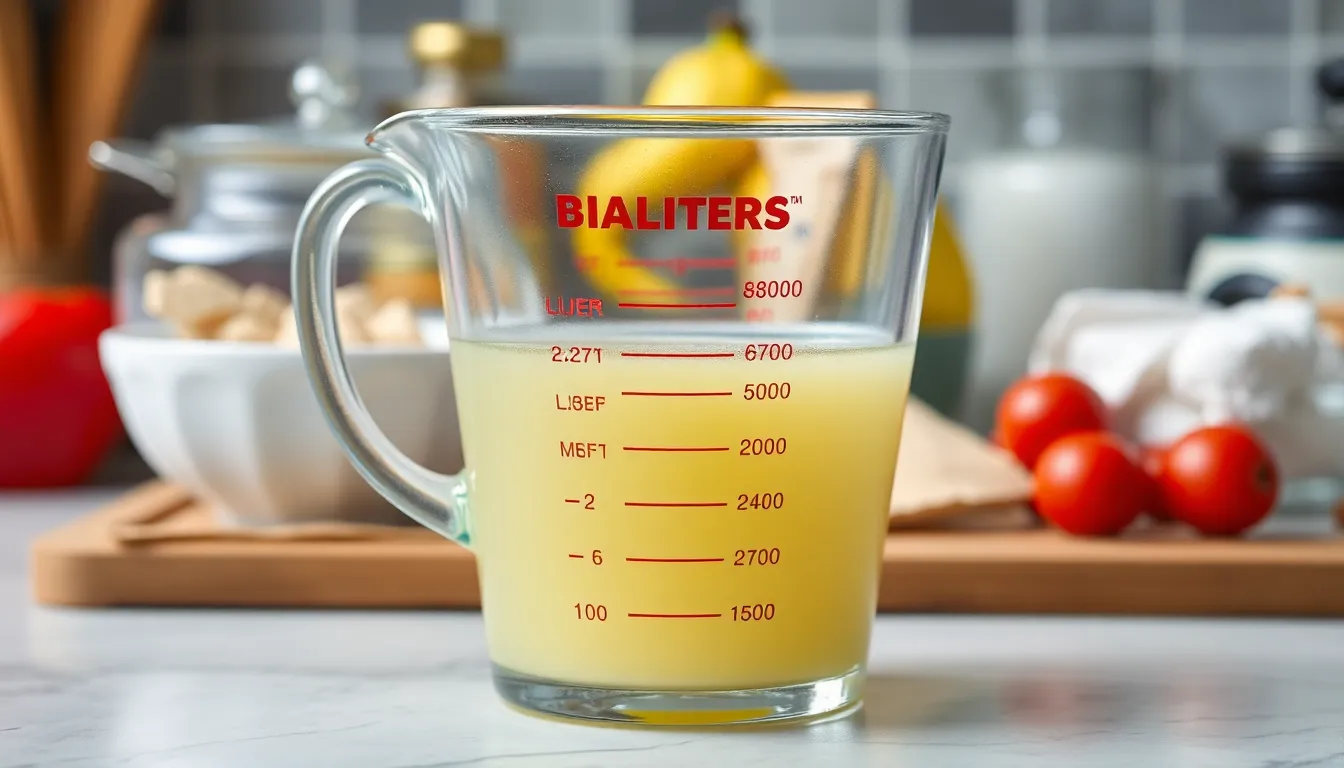When it comes to measuring liquids, the metric system can feel like a maze of numbers and conversions. Ever found yourself staring at a recipe that calls for milliliters while your measuring cup only shows liters? It’s enough to make anyone question their life choices. But fear not! Understanding how many milliliters are in a liter can turn that confusion into confidence.
Table of Contents
ToggleUnderstanding Volume Measurements
Volume measurements play a crucial role in cooking and various scientific applications. A liter is a fundamental unit of volume in the metric system. It equates to 1,000 milliliters, allowing for straightforward conversions between these two units.
Milliliters are often used in recipes for precision. Accurate measurements ensure desired outcomes when preparing food and beverages. Understanding this conversion helps eliminate confusion when measuring liquids. For instance, if a recipe calls for 500 milliliters, it translates to 0.5 liters.
Different industries utilize these measurements according to specific needs. In healthcare, for example, certain medications are prescribed in milliliters to guarantee proper dosage. Similarly, laboratories use liters and milliliters to prepare solutions and conduct experiments.
Conversions are simple. For instance, doubling the liters results in 2,000 milliliters. Reducing liters by half gives 500 milliliters. This consistency streamlined by the metric system enhances clarity and efficiency in liquid measurements.
Visual aids can also assist in comprehending volume. Measuring cups often indicate both liters and milliliters. Using these dual markings helps in visualizing the quantity of liquid measured, further facilitating understanding.
Effective measurement is vital in daily life, whether in a kitchen or laboratory. Familiarity with these conversions increases confidence when handling liquids. Practicing this knowledge through repetitive usage can reinforce comprehension and application.
The Basics of Liters and Milliliters

Understanding liters and milliliters is essential for accurate liquid measurements. These units are fundamental in both cooking and scientific fields.
What Is a Liter?
A liter defines a metric unit of volume, equal to 1,000 milliliters. This unit is commonly used across various applications, from cooking recipes to scientific experiments. The liter provides a straightforward way to measure larger volumes of liquid. Often, people use liters when discussing quantities like beverages or larger ingredients. The symbol for liter is “L”. Recognizing liters facilitates an easier conversion to milliliters. For example, when a recipe calls for one liter, it precisely translates into 1,000 milliliters.
What Is a Milliliter?
A milliliter is a smaller metric unit of volume, representing one-thousandth of a liter. It plays a crucial role in precise measurements, particularly in medicine and research. Medical dosages often specify milliliters for accuracy. Recipes may also list ingredients using milliliters to ensure the correct proportions. The symbol for milliliter is “mL”. Knowing milliliters helps individuals measure small amounts of liquids with confidence. This unit aids in the creation of consistent outcomes in both culinary and scientific activities.
Conversion Between Liters and Milliliters
Understanding the conversion between liters and milliliters enhances confidence in measuring liquids accurately. A liter equals 1,000 milliliters, making this relationship crucial in various contexts.
How Many mls in a Liter?
One liter contains 1,000 milliliters. For instance, when a recipe requires 500 mL, it specifies half of a liter. To convert liters to milliliters, simply multiply the number of liters by 1,000. This straightforward formula facilitates quick calculations and ensures accurate measurement, especially in cooking or scientific applications.
Practical Examples of Conversion
Converting between liters and milliliters can be experienced in everyday activities. For example, a 2-liter bottle of soda contains 2,000 mL. In another case, 250 mL of water equals 0.25 liters, often useful in precise cooking measurements. When measuring out doses in healthcare, knowing that 5 mL equals 0.005 liters supports accurate medication administration. Such examples demonstrate the practical importance of understanding volume conversions.
Importance of Accurate Measurements
Accurate measurements play a crucial role in various fields, especially in cooking and scientific settings.
Applications in Cooking and Science
Precision in measurements directly impacts cooking results. Recipes often specify ingredients in milliliters, ensuring flavors balance correctly. In scientific applications, milliliters are essential for accurate dosing in medicines and experiments. For instance, chemists rely on specific volumes for chemical reactions to yield desired results. Using the correct unit enhances consistency in outcomes, making accuracy vital whether in a kitchen or laboratory.
Avoiding Common Mistakes
Common mistakes arise when converting between liters and milliliters. Misunderstanding that one liter equals 1,000 milliliters can lead to significant errors. For example, pouring 500 mL instead of 50 mL can dramatically affect a recipe or medication dosage. Familiarizing oneself with unit symbols also helps. Remember, “L” signifies liters, while “mL” denotes milliliters. Grasping these distinctions minimizes errors and fosters confidence in measurements.
Understanding the relationship between liters and milliliters is essential for anyone working with liquid measurements. With one liter equaling 1,000 milliliters, making conversions becomes a seamless process. This knowledge not only enhances confidence in the kitchen but also ensures precision in scientific and medical applications.
By familiarizing oneself with these units and their symbols, individuals can avoid common pitfalls in measurement. Whether cooking a recipe or preparing a solution in a lab, accurate volume measurements lead to successful outcomes. Embracing these conversions empowers individuals to handle liquids effectively in their everyday lives.





